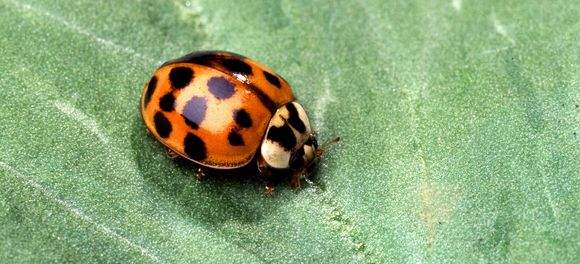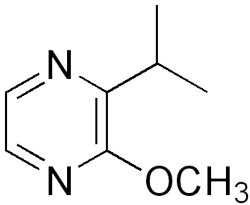
One stinky bug: The Asian ladybeetle (Photo courtesy of USDA Agricultural Research Service)
By Tom Mansell, Science Editor
Have you ever picked up an ant and squished it between your fingers? In some cases, the ant has the last laugh, leaving your fingers with a sickly sweet, pungent odor sometimes described as "rotten coconuts." Ants secrete all kinds of different chemicals for communication, stress, antibacterial, antifungal and many other reasons.
Unfortunately, this is also true of insects in the vineyard.
One particular insect can secrete a chemical so potent, as little as one bug per liter of juice can ruin an entire batch of wine. I'm talking about the multi-colored Asian ladybeetle, Harmonia axyridis. This little guy lives in lots of vineyards and farm fields across the country, eating aphids and doing some other beneficial pest control.
 The problem is that when this beetle is under stress (e.g., being crushed in a bladder press), it releases some very potent aroma compounds, including 2-methoxy-3-isopropyl-pyrazine (IPMP, pictured right).
The problem is that when this beetle is under stress (e.g., being crushed in a bladder press), it releases some very potent aroma compounds, including 2-methoxy-3-isopropyl-pyrazine (IPMP, pictured right).
If you're really into wine, the word "methoxypyrazine" might look familiar. It's the name of a group of chemical compounds naturally found in grapes, particularly before véraison. Methoypyrazines are responsible for a variety of "green" or vegetal aromas in wines. IBMP (2-methoxy-3-isobutyl-pyrazine), the chief MP in unripe grapes, is responsible for a green bell pepper aroma, while IPMP smells like peas and rancid peanut butter.
Methoxypyrazines have a detection threshold in the neighborhood of 1-20 parts per trillion. This threshold is about thousands to millions of times more than many of the other wine impact odorants (with the exception of cork taint, which is similarly potent). To put this into perspective, 3-4 milligrams of IPMP would be enough to make an Olympic-sized swimming pool (~600,000 gallons) smell like peas.
While it's theoretically interesting to wine geeks like myself, finding so-called "ladybug taint" in a commercial wine is exceedingly rare, given that (1) ladybeetle infestations of the degree required to taint finished wine are somewhat rare and depend on the location of the vineyard, if there are soybeans nearby, and lots of other factors, and (2) the wine is usually revolting and unsellable.
Imagine my surprise, then, when I recently visited a winery and tasted a wine with unmistakable ladybug taint aroma. Needless to say, I immediately bought a bottle. The wine reeks of peanuts immediately after uncorking, and tastes even worse, with notes of mushy, school cafeteria peas.
I should note that this was not a New York winery, but the grapes were indeed from New York State. I don't necessarily want to mention the name of the winery because I can't prove that the IPMP is due to ladybeetles, but I can say with relative certainty that it is IPMP, and lots of it! If you want to try this wine for yourself, send me an email, though I don't believe it's for sale online. If you're around Ithaca, I still have a lot of the bottle left (for obvious reasons), so I'll gladly pour you some.
If you are trained to pick up faults in wine, sometimes you can become obsessed with them. It's important to remember that when it comes to wine, the absence of fault is not the presence of greatness. Indeed, some things that at very high concentrations can be considered faulty can be pleasurable and/or add complexity at low concentrations (Brett comes to mind, at least for some people…). Even methoxypyrazines can be desirable in some styles of wine (e.g., New Zealand Sauvignon Blanc).
That being said, I may forget some of the really good, unfaulted wines that I have had, but I will never forget this one.
Further reading:
Review of methoxypyrazines in wine from Wines & Vines, featuring work from Cornell researchers on managing MPs in the vineyard
